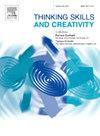Exploring creative thinking skills and creativity in English courses through the lenses of creative pedagogy in two continuum IB schools
IF 3.7
2区 教育学
Q1 Social Sciences
引用次数: 0
Abstract
Creativity and creative thinking skills are imperative in the 21st-century workforce and are integral to modern educational curricula. The International Baccalaureate (IB) stands out for seamlessly incorporating these skills into its Primary Years Programme (PYP), Middle Years Programme (MYP), and Diploma Programme (DP). However, the interchangeable use of the terms creativity and creative thinking skills presents challenges to their differentiation and integration into teaching practices. This study examines the roles of creativity and creative thinking skills in two continuum IB schools in Türkiye. Lin’s (2011) creative pedagogy framework, which originally included teaching creatively, teaching for creativity and creative learning as the core components, has been revised twice for the current study. It now includes creative thinking skills as the fourth component and this is one of the major contributions of this research. Our findings revealed that IB curricula foster creativity and creative thinking skills, but the teachers faced some challenges as a result of the demanding nature of the curricula and time constraints. This multiple case study followed a concurrent mixed-methods approach employing semi-structured teacher interviews, questionnaires and class observations as data sources to ensure triangulation. Based on the findings, each component of the framework has been redefined from the IB perspective. Thus, the final version of the framework, the Creative Pedagogy Framework for Continuum IB Schools, offers a systematic infusion of each component mentioned previously into IB curricula in continuum IB schools, addressing challenges and enhancing integration.
通过两所连续IB学校的创造性教学法,探索英语课程中的创造性思维技能和创造力
创造力和创造性思维技能在21世纪的劳动力中是必不可少的,也是现代教育课程的组成部分。国际文凭课程(IB)将这些技能无缝地融入其小学课程(PYP),中学课程(MYP)和文凭课程(DP)中。然而,创造性和创造性思维技能这两个术语的可互换使用给它们的区分和融入教学实践带来了挑战。本研究考察了创造力和创造性思维技能在泰国两所连续IB学校中的作用。Lin(2011)的创造性教学法框架,最初包括创造性教学、创造性教学和创造性学习作为核心组成部分,为本研究进行了两次修订。它现在包括创造性思维技能作为第四个组成部分,这是本研究的主要贡献之一。我们的研究结果表明,IB课程培养了创造力和创造性思维技能,但由于课程的要求和时间限制,教师面临着一些挑战。该多案例研究采用并行混合方法,采用半结构化教师访谈、问卷调查和课堂观察作为数据源,以确保三角测量。根据研究结果,从IB的角度重新定义了框架的每个组成部分。因此,该框架的最终版本,即连续IB学校创造性教学法框架,将前面提到的每个组成部分系统地注入到连续IB学校的IB课程中,以应对挑战并加强整合。
本文章由计算机程序翻译,如有差异,请以英文原文为准。
求助全文
约1分钟内获得全文
求助全文
来源期刊

Thinking Skills and Creativity
EDUCATION & EDUCATIONAL RESEARCH-
CiteScore
6.40
自引率
16.20%
发文量
172
审稿时长
76 days
期刊介绍:
Thinking Skills and Creativity is a new journal providing a peer-reviewed forum for communication and debate for the community of researchers interested in teaching for thinking and creativity. Papers may represent a variety of theoretical perspectives and methodological approaches and may relate to any age level in a diversity of settings: formal and informal, education and work-based.
 求助内容:
求助内容: 应助结果提醒方式:
应助结果提醒方式:


